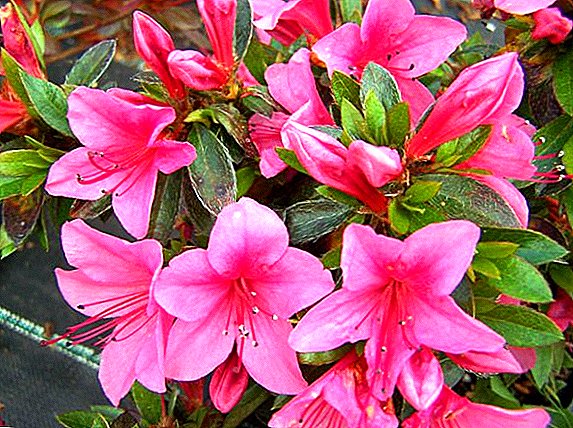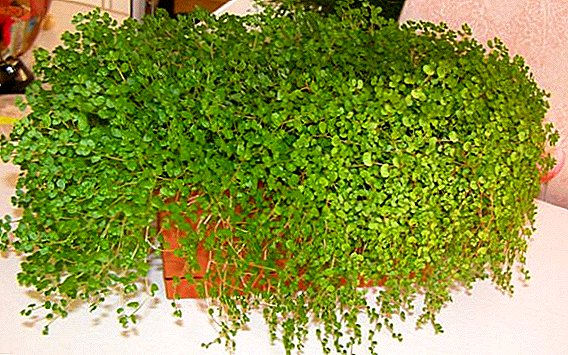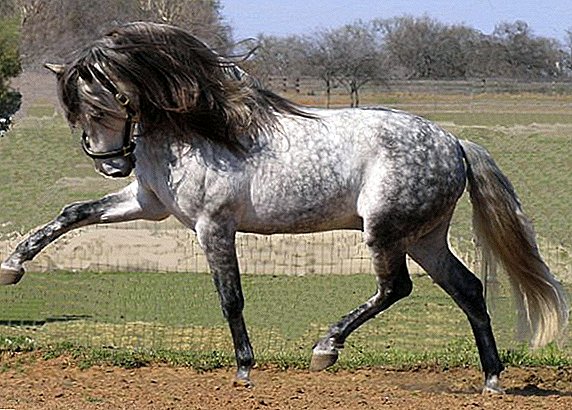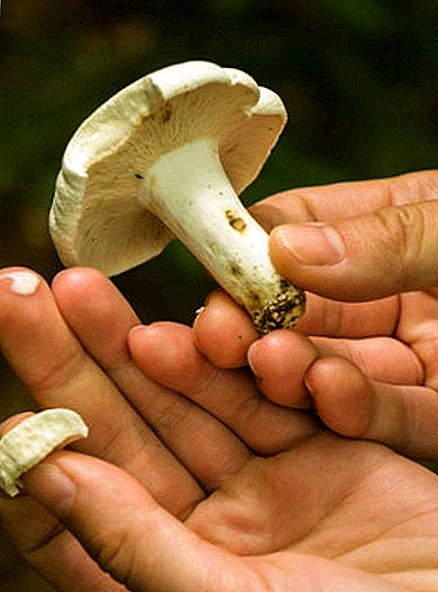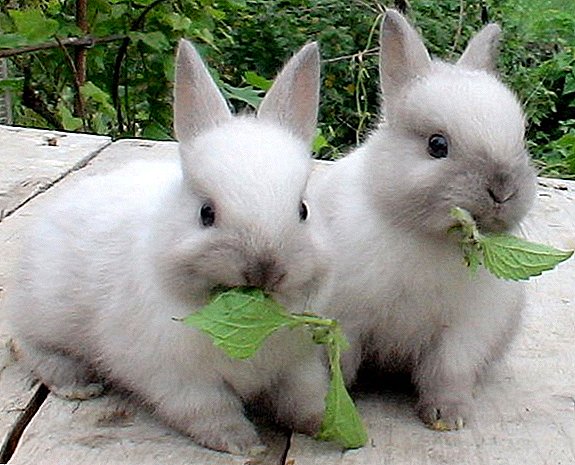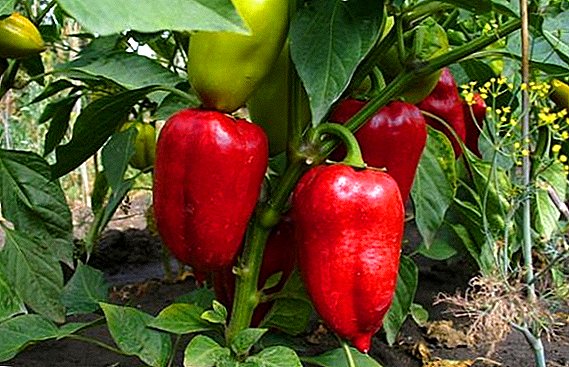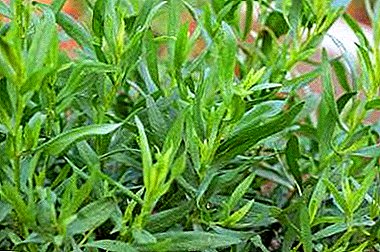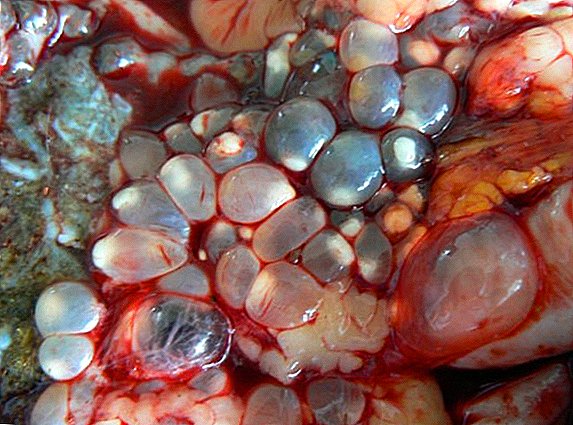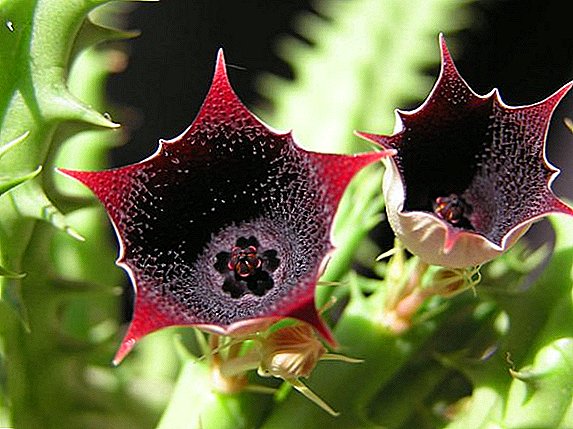 Guernia is quite rare on the window sills lovers of indoor flowers, although unpretentious in the care. During flowering, it looks quite attractive, so that the plant and is of interest among growers. Description and features of the cultivation of Guernias consider in the article.
Guernia is quite rare on the window sills lovers of indoor flowers, although unpretentious in the care. During flowering, it looks quite attractive, so that the plant and is of interest among growers. Description and features of the cultivation of Guernias consider in the article.
Botanical description of indoor plants
This succulent belongs to the Lastovnev family. South Africa and the Arabian Peninsula are considered its birthplace. This plant is a perennial, usually has 4-5 stems of green color, they sometimes can be seen marble color or red stains. Stems ribbed with small pointed teeth that do not have needles. This succulent can grow up to 30 cm. There are both upright and creeping species.
The leaves of guernias are very small, but they also dry out quickly and fall off. Processes that are formed from lateral buds can also move away from the stems. Thus, the succulent becomes similar to a branchy bush, which is attached to the soil by small roots, located in the upper layer of the soil.

Flowers in size from 5 to 10 cm, have a different color depending on the variety. They appear in place of flower buds. Each flower is located on a thin stalk. The shape of the inflorescences may look like a star or a crown. The skin on them is smooth, and in the middle there is a pharynx with small papillae. Flowers can be both monophonic, and with impregnations.
Pollination of a flower occurs due to flies, and in order to attract them, the power plant emits an unpleasant smell, which only intensifies with the onset of heat. One flower can live no more than 2 days, but the inflorescences are blooming in large quantities, because of which the flowering process itself lasts several months. The period of active flowering occurs in June - September. The peculiarity of the flowers is that they bloom starting from the base. In place of the flower, after successful pollination, a fruit appears with small seeds inside.
Did you know? The plant variety Wormworms, which is found in South Africa, besides the specific smell, also has the ability to produce heat, the same as when meat is rotting. It so misleads flies that they often lay larvae there, as if on a genuine carrion.
Plant species
The genus of guernias has more than 60 species of this plant. Most have a similar appearance, but many radically differ in shape and color:
- Kenyan. The stems are directed downwards, and their length is about 30 cm. There are ribs with teeth on the shoots. In June, flowering begins, which is characterized by the appearance of inflorescences of several buds. The flowers are like bowls of purple. One flower reaches 3 cm in diameter.
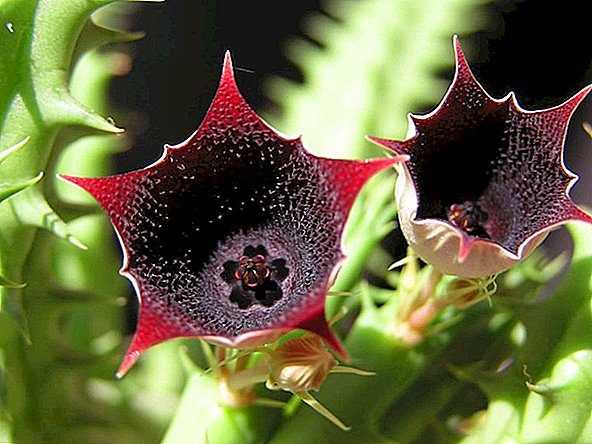
- Zebrina. It grows no more than 10 cm. The stems have 4 edges, and their width is about 2 cm. From the sun on the skin of the plant can appear reddish stains. The flower resembles a star with a fused core, its diameter is about 7 cm. In the middle it is painted in burgundy color, and is thickly covered with yellow stripes at the tips.

- Large fruit. Stems grow up and have a bluish outflow. The height of the plant is about 20 cm. There are 7 ribs on the stem, and the inflorescences have 5 buds each. Flowers burgundy in color with dark blotches, their diameter is 2 cm.
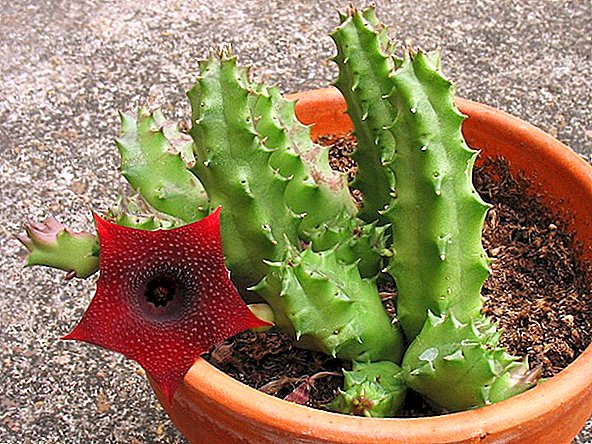
- Rough. The shoots are quite thin, about 1.5 cm wide, have 5 edges. The flowers are shaped like a bell with 5 petals. Pink colour. The base is covered with long dark papillae.
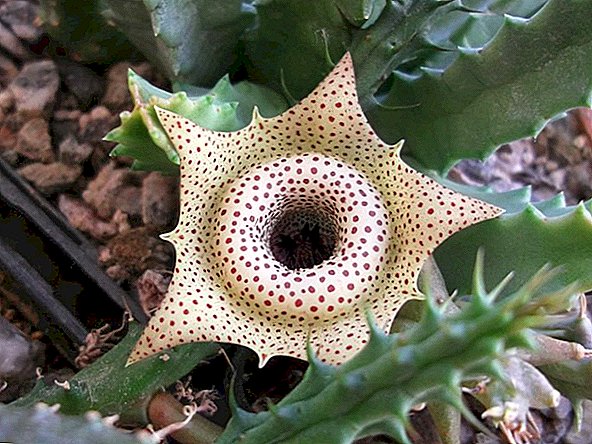
- Hairy. It has thick short stems, densely covered with teeth. It looks like a familiar cactus. The shoots themselves are bright green in color, the tips are painted red on the teeth. Flowers have a fleshy structure and look like a starfish, their diameter ranges from 2.5 to 5 cm. The color of the inflorescences can be red, yellow or terracotta.
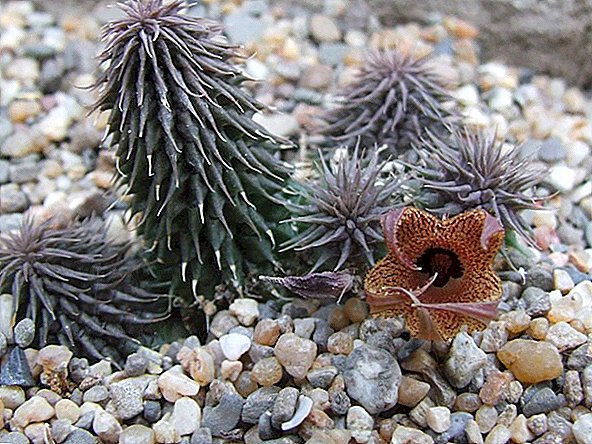
- Graceful. The shoots are rounded, with 5 facets, light green in color. Flowers are shaped like sand-colored crowns. Inside the flower is covered with burgundy dots.
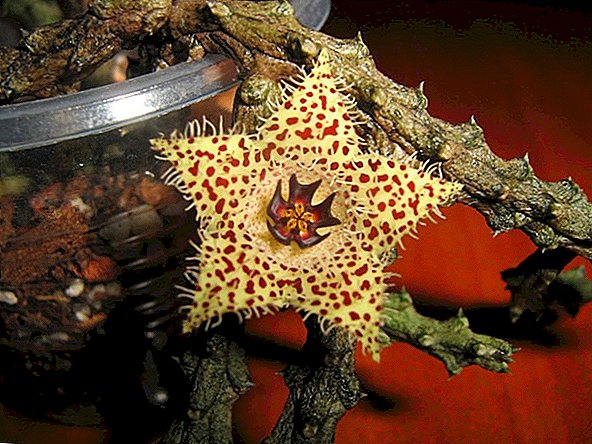
Conditions for growing at home
This plant can grow even inexperienced growers, because it is quite unpretentious in the care. The rules of cultivation do not have any features, so the conditions for it should be created the same as for the other indoor plants.
Location and lighting
It is better to have a plant on the east or west side of the apartment. All day the sun's rays should illuminate the plant. This succulent grows beautifully in a well-lit place, but at lunchtime the scorching rays can harm the plant, so you need to priten it for a couple of hours a day. If there is little light, the shoots will become elongated and thin.
See also 10 popular home blooming cacti with a description and photo.In this case, it is recommended to use special lamps, especially their relevance increases in winter. In addition, it is worth remembering that this succulent does not like changing habitual habitat. The lighting must constantly fall at the same angle, so do not turn the pot or move it. Due to changes in the location of the power plant can reset buds and flowers.
Temperature conditions
When the weather is warm outside, and the air temperature is from +23 to + 27 ° C, you can safely take out the huerniya to the balcony, where it will live until the first cold snaps. Usually this period is 4 months - from May to early October. In winter, succulent must be placed in cooler conditions. The temperature in the room should be from +5 to + 10 ° C.

Air humidity
If the room is dry air - this is not a hindrance to the power supply. It does not require hydration or spraying, and you should not wash the plant under the shower. This succulent is very susceptible to the appearance of rot on the stems, so the humidity level of the air should be about 30%. To remove dust and other contaminants from the stalks, it is best to simply wipe their skin with a damp natural cloth, cotton wool or a napkin.
Important! If the guernia gets into an overly humid environment, then in just a couple of days the stems will turn into slime.
Home care
When growing this succulent at home, it is necessary to observe some subtleties, which also depend on the season.
Watering rules
In the summer and spring, it is recommended to irrigate the plant in the spring only after the soil has dried to 50%. Overfilling of the soil is dangerous for the plant, as the swampy and soured soil can lead to the death of the succulent. Due to errors in watering, the plant can become infected with fungi that cause rot on the stem or rhizome.
To save the plant is very difficult, and it can die in just a week. In winter, it is necessary to significantly reduce watering or stop them altogether. For proper procedure, the water temperature must correspond to the air temperature in the room. It is better to water the succulent under the root - so that the drops do not remain on the stem and flowers.
Top dressing
Top dressing for guernia should be applied to the soil 1-2 times per month, however, this should not be done during the rest period. For the procedure can be purchased at the store already ready fertilizer for cacti or succulents.

Such preparations contain the necessary amount of minerals and nutrients for the plant, which allows it to grow well and bloom profusely. In addition, it is worth paying attention to the fact that the fertilizer does not have nitrogen in its composition, or at least it was contained in small quantities. It is not necessary to feed the plant in winter.
Pruning
By itself, the power does not reach large sizes in growth, therefore, its shoots should not be cut off. If desired, this can be done during transplantation - in this case, it is necessary to process the sections with wood ash. Mandatory pruned only dried shoots.
Transfer
Replant this succulent is only necessary in the spring. At the same time, a new pot should be selected a couple of centimeters more than the previous one.
Important! The composition of the soil should be the same as the one in which the power plant grew before transplanting.
Young plants require an increase in the pot every year, so their transplantation is done most often. This is due to the intensive growth and release of shoots of the plant in this period of life. But the roots of this plant do not take up much space, so the transplantation of already adult specimens is performed no more than once every 2-3 years.
If the soil is not infected and does not contain fungi, then the plant is recommended to transplant using the transshipment method: this way you will not damage the delicate roots. Otherwise, it is better to completely replace the soil. Also when transplanting experienced flower growers are advised to remove the old stem, and plant only young shoots.
Breeding
This succulent is able to reproduce by cutting and seeds, which most often occurs in nature. In the conditions of the apartment you choose which method is more acceptable for you. And in order for the process to be productive, it is necessary to take into account certain nuances.

Cuttings
To implement this method, you first need to separate the young shoots from the old. After that, the shoots are postponed for 24 hours so that they can wither.
After a day you can land the young Guernias in a mixture of coarse sand and peat. The air temperature in the room should be + 20 ° С. After one and a half weeks roots will appear on the cuttings. This is a sign that it is possible to plant the strengthened specimens in permanent pots with a diameter of about 7 cm.
The soil must be prepared in advance. For this you need to mix:
- 1 part of sand;
- 2 pieces of leafy ground;
- 1 part turf;
- 1 part mixture of coal and lime in a ratio of 1 to 8.
Read tips on caring for the Decembrist flower at home.
Seeds
Seeds of this succulent can be bought, but it is better to collect your own. Usually they are located in the fruits that are on the inflorescences. After collecting the grains, it is necessary to remove fluff on them. Then the material is placed in a solution of potassium permanganate and sown. To begin with, it is necessary to plant the seeds in separate containers, in which sandy soil or store substrate for succulents is prepared in advance.

It takes about a month for seed to germinate. All this time, the soil is moderately moistened. At the same time it is not recommended to cover pots with foil or glass. When the seeds germinate, they can be planted in separate pots with a diameter of 6 cm. The composition of the soil should be the same as in propagation by cuttings.
It is worth remembering that the power plant grows quite quickly and is easily pereopyletsya, in this regard, young plants may in some way differ from the parent specimen. In addition, do not allow the land to dry out in the first year of life of the succulent. Gerbed seeds sprouted from seeds begin to bloom within 3-4 years after germination.
Difficulty growing
Sometimes on the succulent stems dark spots can be observed - these are burns from the scorching sunlight. In this case, it is necessary to priten the plant with a cloth or paper. But do not be zealous with this, because the plant will become very pale and unattractive. Destructive for Guernia are overflow of soil and high humidity.
Did you know? Seeing these plants for the first time, Goethe described them as "the most beautiful, most monstrous flowers" because of their strong smell. And the British called Guerniya bad-fish, because its flavor resembles a rotten fish.If there is too much moisture, then a powdery mealybug can appear on the flower, which will lead to fungal diseases. In order to get rid of it, you need to treat the plant with insecticides, such as "Aktara" or "Intavir". Also, excessive moisture can cause rot on the plant. It appears brown or gray spots on the trunk. In this case, immediate removal of affected areas and drainage of the soil will help.
Due to the fact that this succulent genetically accustomed to adapt to the harsh desert, with his home cultivation problems usually do not arise. Observing all the recommendations for growing a powerhouse, even an inexperienced florist can get this exotic plant on its windowsill.








